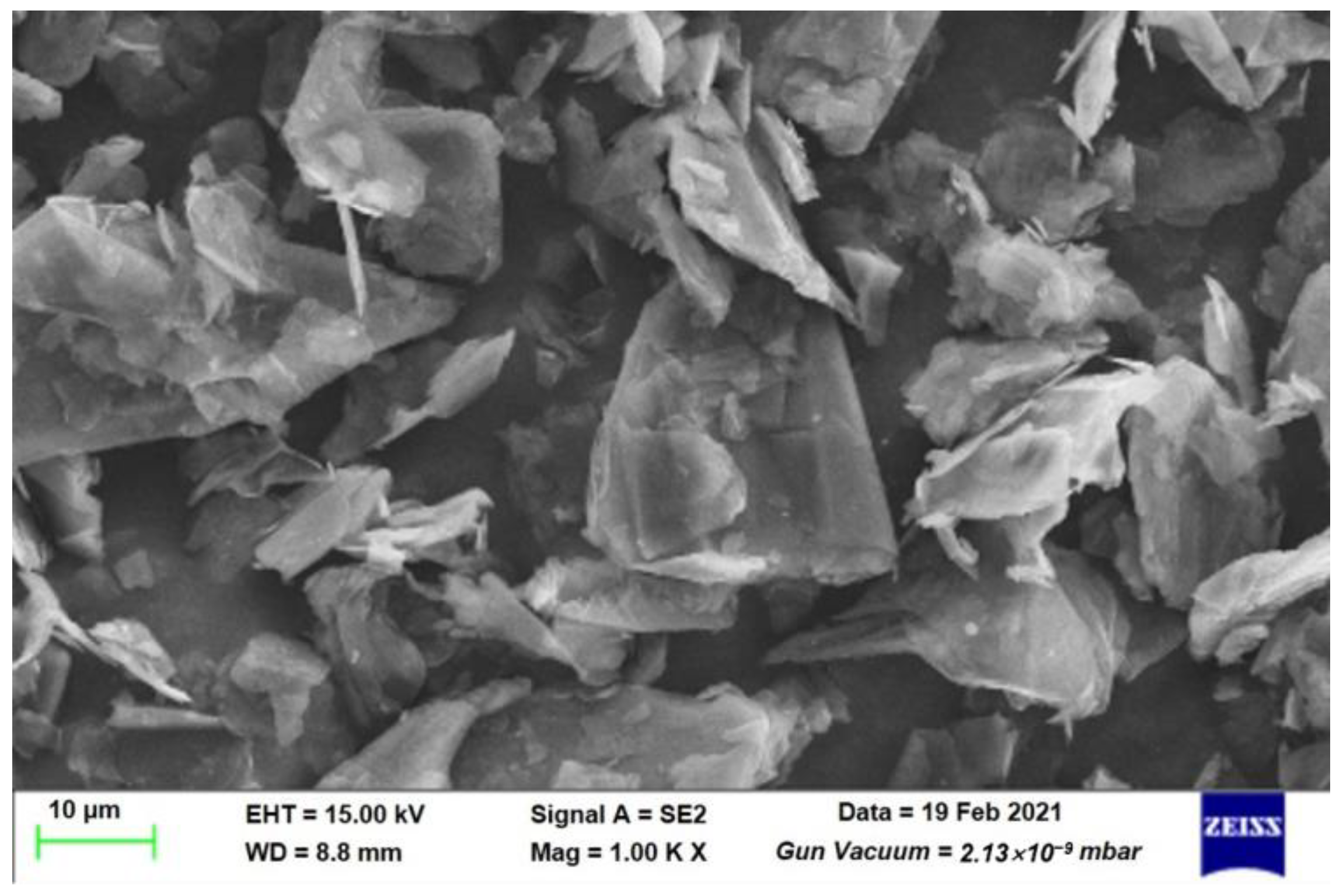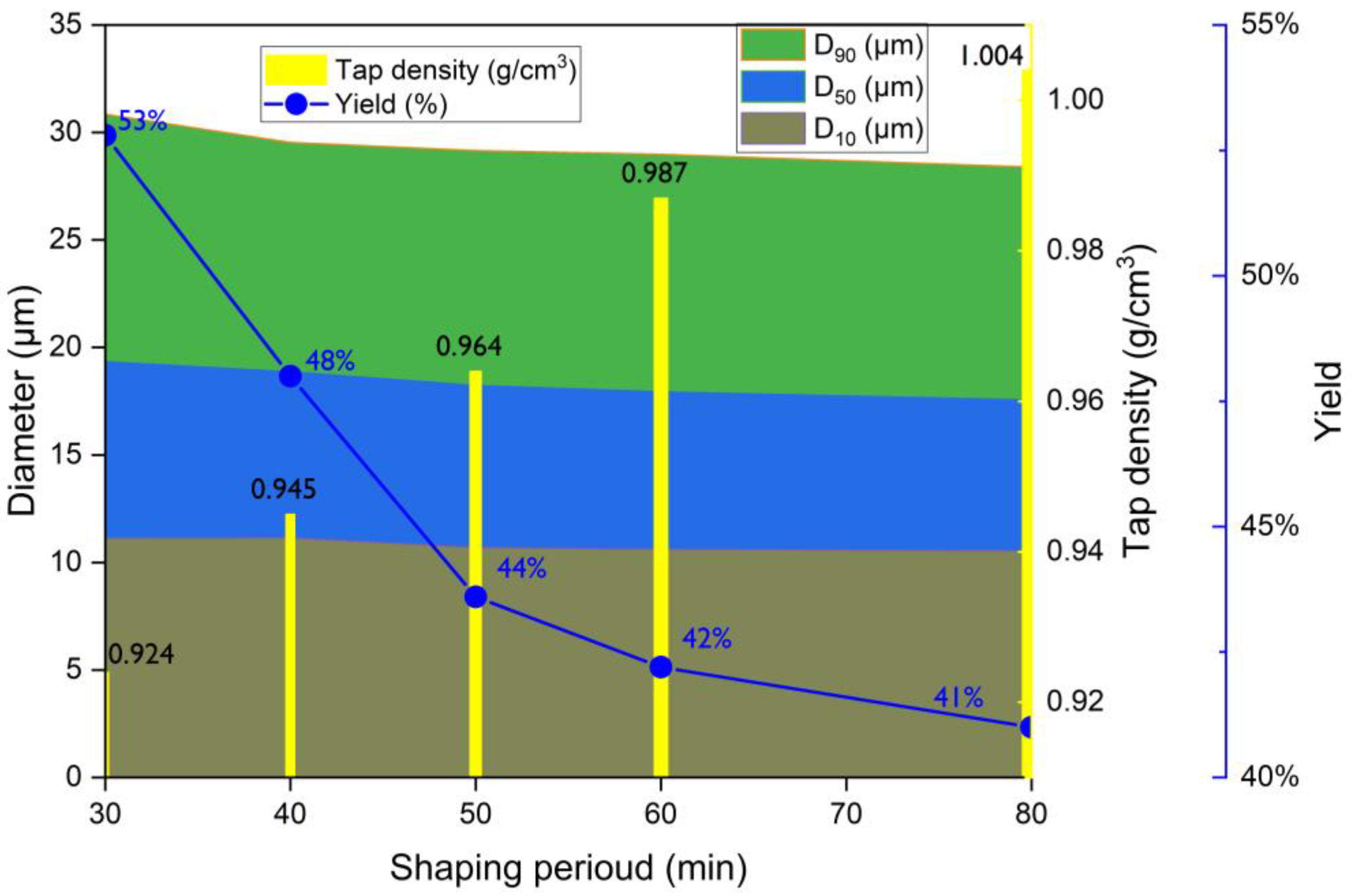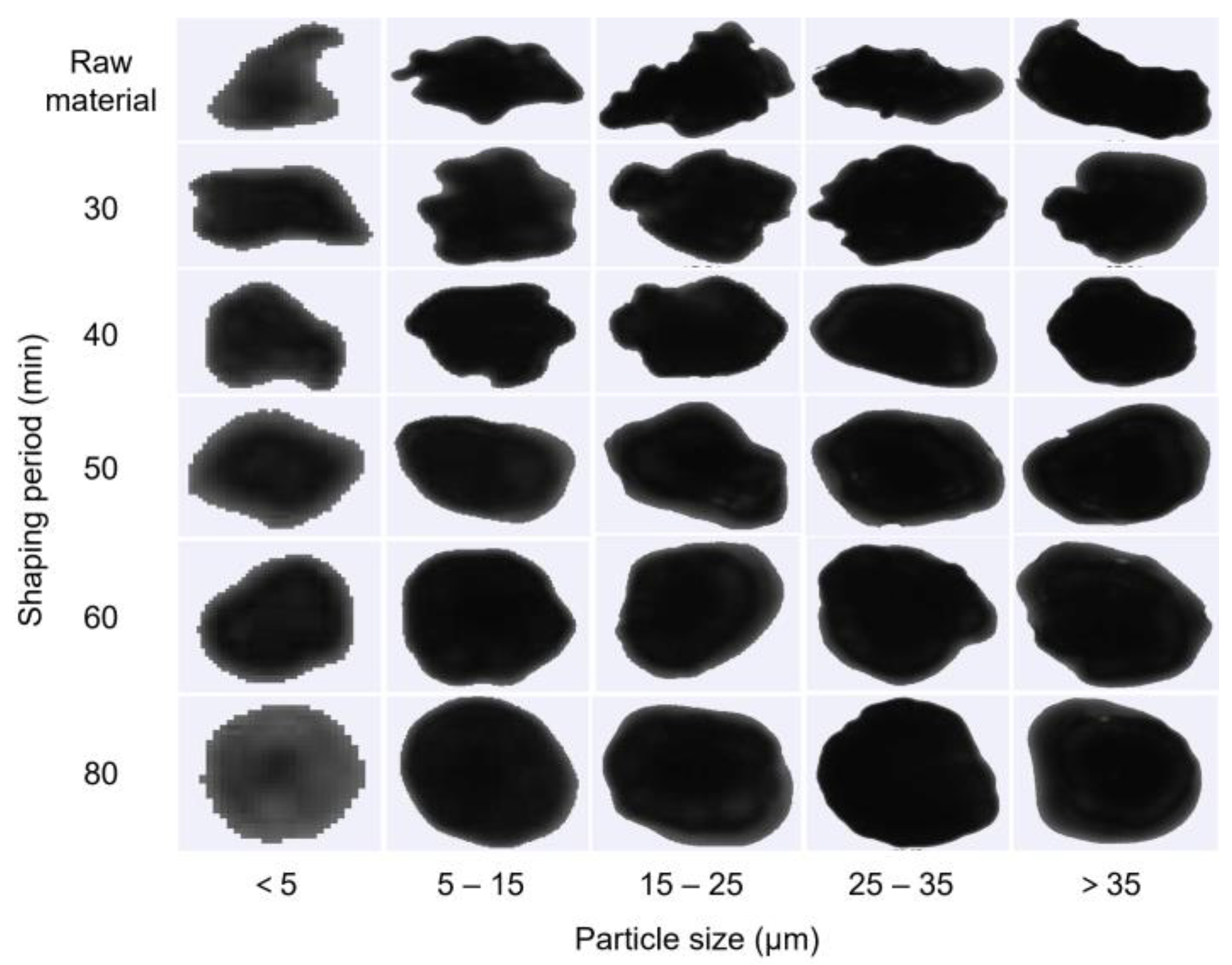Improved Technology for Rounding Graphite: Machine Structure and Industrial Test
Abstract
:1. Introduction
2. Materials and Methods
2.1. Materials
2.2. Structure of Rounding Machine for Graphite
2.3. Working Mechanism of the Proposed Rounding Machine
2.4. Graphite Rounding System
2.5. Investigation of Parameters for Graphite Rounding
2.6. Characterization Methods
3. Results and Discussion
3.1. Rounding Effect
3.1.1. Effect of the Rotating Speed of Shaping Disk on Graphite Rounding
3.1.2. Effect of the Shaping Period on Graphite Rounding
3.1.3. Effect of the Rotating Speed of Classifier on Graphite Rounding
3.1.4. Discussion on Degree of Sphericity of Graphite Particle Impacted by Shaping Period and Shaping Disk Rotating Speed
3.1.5. Discussion on Shape of Graphite Particle Impacted by Shaping Period
3.2. Optimized Test
4. Conclusions
Author Contributions
Funding
Institutional Review Board Statement
Informed Consent Statement
Data Availability Statement
Acknowledgments
Conflicts of Interest
References
- Zhao, F.; Zhao, M.; Dong, Y.; Ma, L.; Zhang, Y.; Niu, S.; Wei, L. Facile preparation of micron-sized silicon-graphite-carbon composite as anode material for high-performance lithium-ion batteries. Powder Technol. 2022, 404, 117455. [Google Scholar] [CrossRef]
- Sun, H.; Song, Q.; Xu, Z. A method for using the residual energy in waste Li-ion batteries by regulating poential with the aid of overvoltage response. Proc. Natl. Acad. Sci. USA 2023, 120, e2213130120. [Google Scholar] [CrossRef] [PubMed]
- Han, L.; Zhu, X.; Yang, F.; Liu, Q.; Jia, X. Eco-conversion of coal into a nonporous graphite for high-performance anodes of lithium-ion batteries. Powder Technol. 2021, 382, 40–47. [Google Scholar] [CrossRef]
- Xiao, J.; Li, J.; Xu, Z. Challenges to future development of spent lithium ion batteries recovery from environmental and technological perspectives. Environ. Sci. Technol. 2020, 54, 9–25. [Google Scholar] [CrossRef] [PubMed]
- Lin, N.; Jia, Z.; Wang, Z.; Zhao, H.; Ai, G.; Song, X.; Bai, Y.; Battaglia, V.; Sun, C.; Qiao, J.; et al. Understanding the crack formation of graphite particles in cycled commercial lithium-ion batteries by focused ion beam—Scanning electron microscopy. J. Power Sources 2017, 365, 235–239. [Google Scholar] [CrossRef]
- Vanderbruggen, A.; Sygusch, J.; Rudolph, M.; Serna-Guerrero, R. A contribution to understanding the flotation behavior of lithium metal oxides and spheroidized graphite for lithium-ion battery recycling. Colloid. Surf. A 2021, 626, 127111. [Google Scholar] [CrossRef]
- Biber, B.; Sander, S.; Martin, J.; Wohlfahrt-Mehrens, M.; Mancini, M. Improved production process with new spheroidization machine with high effciency and low energy consumption for rounding natural graphite for Li-ion battery applications. Carbon 2023, 201, 847–855. [Google Scholar] [CrossRef]
- Mundszinger, M.; Farsi, S.; Rapp, M.; Golla-Schindler, U.; Kaiser, U.; Wachtler, M. Morphology and texture of spheroidized natural and synthetic graphites. Carbon 2017, 111, 764–773. [Google Scholar] [CrossRef]
- Wu, Y.S.; Yeh, T.S.; Lee, Y.H.; Lee, Y.C. Spheroidization modification of artificial graphite applied as anode materials for high rate lithium ion batteries. Adv. Mater. Res. 2011, 201–203, 421–424. [Google Scholar] [CrossRef]
- Mancini, M.; Martin, J.; Ruggeri, I.; Drewett, N.; Axmann, P.; Wohlfahrt-Mehrens, M. Enabling fast-charging lithium-ion battery anodes: Influence of spheroidization on natural graphite. Batter. Supercaps 2022, 5, e202200109. [Google Scholar] [CrossRef]
- Teng, D.L.; Li, P.; Yuan, N.; Lv, J.; Chen, J.D.; Lin, L.Y.; Chen, H.Y. Process parameters optimization of natural graphite spheroidization. China Powder Sci. Technol. 2021, 27, 70–76. (In Chinese) [Google Scholar]
- Peng, H.E.; Zhang, Z.; Xiao, X. Application and prospect of natural graphite spheroidization equipment. China Non-Met. Miner. Ind. 2020, 4, 6–9. (In Chinese) [Google Scholar]
- Yoshio, M.; Wang, H.; Fukuda, K.; Umeno, T.; Abe, T.; Ogumi, Z. Improvement of natural graphite as a lithium-ion battery anode material from raw flake to carbon-coated sphere. J. Mater. Chem. 2004, 14, 1754–1758. [Google Scholar] [CrossRef]
- Park, Y.S.; Lee, T.W.; Shin, M.S.; Lim, S.H.; Lee, S.M. Modification for improving the electrochemical performance of spherically-shaped natural graphite as anode material for lithium-ion batteries. J. Electrochem. Soc. 2016, 163, A3078–A3086. [Google Scholar] [CrossRef]
- Prakash, S.; Kumar, R.; Gupta, A.; Chaudhary, A.; Chandaliya, V.K.; Dash, P.S.; Gurunathan, P.; Ramesha, K.; Kumari, S.; Dhakate, S.R. A process for developing spherical graphite from coal tar as high performing carbon anode for Li-ion batteries. Mater. Chem. Phys. 2022, 281, 281. [Google Scholar] [CrossRef]
- Shi, M.; Tai, Z.; Li, N.; Zou, K.; Chen, Y.; Sun, J.; Liu, Y. Spherical graphite produced from waste semi-coke with enhanced properties as an anode material for Li-ion batteries. Sustain. Energy Fuels 2019, 3, 3116–3127. [Google Scholar] [CrossRef]
- Fischer, S.; Doose, S.; Müller, J.; Höfels, C.; Kwade, A. Impact of Spheroidization of Natural Graphite on Fast-Charging Capability of Anodes for LIB. Batteries 2023, 9, 305. [Google Scholar] [CrossRef]
- Ohzeki, K.; Saito, Y.; Golman, B.; Shinohara, K. Shape modification of graphite particles by rotational impact blending. Carbon 2005, 43, 1673–1679. [Google Scholar] [CrossRef]
- Huang, Q.; Liu, J.; Yu, Y. Turbo air classifier guide vane improvement and inner flow field numerical simulation. Powder Technol. 2012, 226, 10–15. [Google Scholar] [CrossRef]









Disclaimer/Publisher’s Note: The statements, opinions and data contained in all publications are solely those of the individual author(s) and contributor(s) and not of MDPI and/or the editor(s). MDPI and/or the editor(s) disclaim responsibility for any injury to people or property resulting from any ideas, methods, instructions or products referred to in the content. |
© 2023 by the authors. Licensee MDPI, Basel, Switzerland. This article is an open access article distributed under the terms and conditions of the Creative Commons Attribution (CC BY) license (https://creativecommons.org/licenses/by/4.0/).
Share and Cite
Chen, J.; Ma, T.; Lu, Y.; Wang, J.; Zhang, M.; Lin, L.; Yan, C.; Li, X.; Chen, H. Improved Technology for Rounding Graphite: Machine Structure and Industrial Test. Appl. Sci. 2023, 13, 9820. https://doi.org/10.3390/app13179820
Chen J, Ma T, Lu Y, Wang J, Zhang M, Lin L, Yan C, Li X, Chen H. Improved Technology for Rounding Graphite: Machine Structure and Industrial Test. Applied Sciences. 2023; 13(17):9820. https://doi.org/10.3390/app13179820
Chicago/Turabian StyleChen, Jundong, Tingting Ma, Yan Lu, Jianbo Wang, Mingxing Zhang, Longyuan Lin, Cuiping Yan, Xue Li, and Haiyan Chen. 2023. "Improved Technology for Rounding Graphite: Machine Structure and Industrial Test" Applied Sciences 13, no. 17: 9820. https://doi.org/10.3390/app13179820
APA StyleChen, J., Ma, T., Lu, Y., Wang, J., Zhang, M., Lin, L., Yan, C., Li, X., & Chen, H. (2023). Improved Technology for Rounding Graphite: Machine Structure and Industrial Test. Applied Sciences, 13(17), 9820. https://doi.org/10.3390/app13179820




